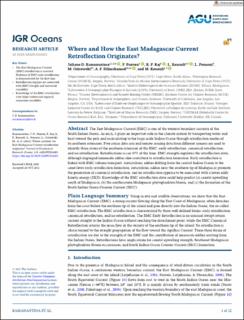| dc.contributor.author | Ramanantsoa, Heriniaina Juliano Dani | |
| dc.contributor.author | Penven, Pierrick | |
| dc.contributor.author | Pappukutty, Raj Roshin | |
| dc.contributor.author | Renault, Lionel | |
| dc.contributor.author | Ponsoni, L | |
| dc.contributor.author | Ostrowski, Marek | |
| dc.contributor.author | Dilmahamod, A.F | |
| dc.contributor.author | Rouault, M | |
| dc.date.accessioned | 2021-11-23T18:51:53Z | |
| dc.date.available | 2021-11-23T18:51:53Z | |
| dc.date.created | 2021-11-15T17:43:42Z | |
| dc.date.issued | 2021 | |
| dc.identifier.citation | Journal of Geophysical Research (JGR): Oceans. 2021, 126 (e2020JC016203), 1-22. | en_US |
| dc.identifier.issn | 2169-9275 | |
| dc.identifier.uri | https://hdl.handle.net/11250/2831123 | |
| dc.description.abstract | The East Madagascar Current (EMC) is one of the western boundary currents of the South Indian Ocean. As such, it plays an important role in the climate system by transporting water and heat toward the pole and recirculating to the large-scale Indian Ocean through retroflection modes of its southern extension. Five cruise data sets and remote sensing data from different sensors are used to identify three states of the southern extension of the EMC: early retroflection, canonical retroflection, and no retroflection. Retroflections occur 47% of the time. EMC strength regulates the retroflection state, although impinged mesoscale eddies also contribute to retroflection formation. Early retroflection is linked with EMC volume transport. Anticyclonic eddies drifting from the central Indian Ocean to the coast favor early retroflection formation, anticyclonic eddies near the southern tip of Madagascar promote the generation of canonical retroflection, and no retroflection appears to be associated with a lower eddy kinetic energy (EKE). Knowledge of the EMC retroflection state could help predict (a) coastal upwelling south of Madagascar, (b) the southeastern Madagascar phytoplankton bloom, and (c) the formation of the South Indian Ocean Counter Current (SICC). | |
| dc.language.iso | eng | en_US |
| dc.rights | Navngivelse-Ikkekommersiell 4.0 Internasjonal | * |
| dc.rights | CC BY-NC 4.0 | |
| dc.rights.uri | http://creativecommons.org/licenses/by-nc/4.0/deed.no | * |
| dc.rights.uri | https://creativecommons.org/licenses/by-nc/4.0/ | |
| dc.title | Where and How the East Madagascar Current Retroflection Originates? | en_US |
| dc.type | Peer reviewed | en_US |
| dc.type | Journal article | en_US |
| dc.rights.holder | © 2021 The Authors | |
| dc.description.version | publishedVersion | |
| cristin.ispublished | true | |
| cristin.fulltext | original | |
| cristin.fulltext | | |
| cristin.qualitycode | 2 | |
| dc.identifier.doi | 10.1029/2020JC016203 | |
| dc.identifier.cristin | 1954833 | |
| dc.source.journal | Journal of Geophysical Research (JGR): Oceans | en_US |
| dc.source.volume | 126 | en_US |
| dc.source.issue | e2020JC016203 | en_US |
| dc.source.pagenumber | 1-22 | en_US |

